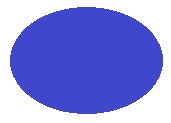Shapes: Aakaar Posted by Nitya on May 10, 2018 in Hindi Language
Shapes आकार (aakaar) are all around us. We use them to describe everyday objects Children are taught to recognize shapes at a very young age. As they enter middle grades and get introduced to geometry in school, the shapes get more complicated. 2D shapes set the base for 3D shapes, however we won’t delve that deep today.
Note: कोण (koN) = angle; भुज (bhuj) = side/arm
वृत्त (vrutta) (noun) = circle/sphere

गोला (gola) = circle/round (noun, common usage)
गोलाकार (golaakaar) = circular (adj., common usage)
 अंडाकृति /अंडाकार (andakruti/andaakaar) = oval
अंडाकृति /अंडाकार (andakruti/andaakaar) = oval

त्रिकोण (trikon) = triangle (noun)
त्रिभुज(tribhuj) = triangle (noun)
त्रिकोणीय (trikoneeya) = triangular (adj.)
त्रिभुजी (tribhuji) = triangular (adj.)
 वर्ग (varg) = square (noun);
वर्ग (varg) = square (noun);
वर्गाकार (vargaakaar) = square (adj.)
आयत(aayat)= rectangle (noun); 
आयताकार (aayataakaar) = rectangular (adj.)
 पंचकोण(panchakoN) = pentagon (noun)
पंचकोण(panchakoN) = pentagon (noun)
पंचभुज (panchabhuj) = pentagon (noun)
पंचकोणीय (panchakoNeeya) = pentagonal (adj.)
पंचभुजी (panchabhuji) = pentagonal (adj.)
 षट्भुज (shutbhuj) = hexagon (noun)
षट्भुज (shutbhuj) = hexagon (noun)षट्भुजी (shutbhuji) = hexagonal (adj.)

Keep learning Hindi with us!
Build vocabulary, practice pronunciation, and more with Transparent Language Online. Available anytime, anywhere, on any device.




Comments:
Ian Rowcliffe:
Hi Nitya: it is interesting that we have to be taught to see the world in this way. When we consider the word ‘shapely’ a different perspective is revealed:
shapely : सुडौल, सुगठित, आनुपातिक, सुरूप, सानुपातिक
I wanted to know why Google translated ‘सुरूप’ as ‘sour’ rather than ‘beauteousness, comeliness, fairness, loveliness’. Is the word ambiguous? P.S. I always read and appreciate your posts. Thanks.
Nitya:
@Ian Rowcliffe Hi Ian,
Thanks for reading and apologies for not getting to this sooner. Suroop is a compound word that consists of the prefix “su” (good) + roop (beauty). I did a quick check and Google did translate it correctly. I’m not sure why you got an error. However, as Rachael pointed out, Google is mostly good for literal translations and it doesn’t always help one learn the contextual nuances of a language.
I hope this helps.
Regards,
Nitya